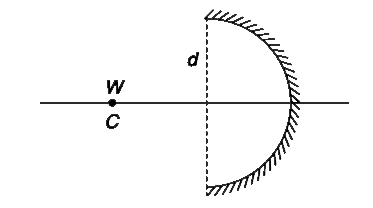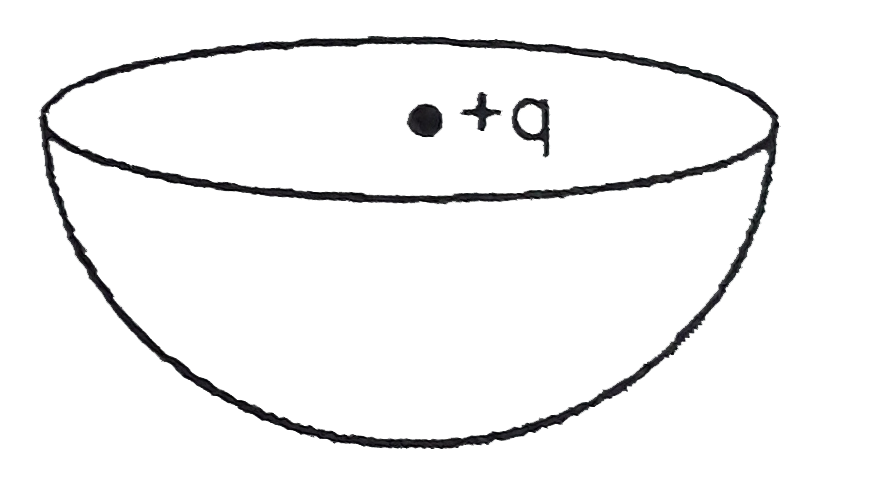A point source of light is placed at the centre of curvature of a hemispherical surface. The radius of curvature is r and the inner surface is completely reflecting. Find the force on the hemisphere due to the light falling on its if the source emits a power W. Solution in Tamil
The energy emitted by the source per unit time, i.e., W
falls on an area 4π(r2) at a distance r in unit time. Thus,
the energy falling per

unit area per unit time is
(W4π(r2)).
Consider a small area dA at the point P of
the hemisphere . The energy falling per
unit time on it is (WdA4π(r2)). The corresponding momentum
incident on this area per unit time is (WdA4π(r2)c).Asthelight<br>isref≤ctedback,thechan≥∈momentumperunit<br>time,i.e.,theforceondAis<br>(dF=(2WdA4π(r2)c).
Suppose the radius OP through the area dA makes an
angle theta with the symmetry axis OX. The force on dA is
along this radius. By symmetry, the resultant force on
the hemisphere is along OX. The component of dF along
OX is
dFcosθ=(2WdA4π(r2)c)cosθ.
If we project the area dA on the plane containing the
rim, the projectin is dA cos theta. Thus, the component of
dF along OX is,
dFcosθ=(2W4π(r2)c)(projectionofdA).
The net force along OX
F=(2W4π(r2)c)(∑projectionofdA).
When all the small areas dA are projected, we get the
area enclosed by the rim which is (π(r2).Thus,<br> (F= (2W/ (4pi (r^2)c)) xx pi (r^2)= (W/2c).)
Topper's Solved these Questions
- PHOTO ELECTRIC EFFECT AND WAVE PARTICLE DUALITYBOOK - HC VERMACHAPTER - PHOTO ELECTRIC EFFECT AND WAVE PARTICLE DUALITYEXERCISE - question for short answer
13 Videos
- PHOTO ELECTRIC EFFECT AND WAVE PARTICLE DUALITYBOOK - HC VERMACHAPTER - PHOTO ELECTRIC EFFECT AND WAVE PARTICLE DUALITYEXERCISE - objective I
14 Videos
- PHOTO ELECTRIC EFFECT AND WAVE PARTICLE DUALITYBOOK - HC VERMACHAPTER - PHOTO ELECTRIC EFFECT AND WAVE PARTICLE DUALITYEXERCISE - Exercise
35 Videos
- PERMANENT MAGNETSBOOK - HC VERMACHAPTER - PERMANENT MAGNETSEXERCISE - Exercise
25 Videos
- PHOTOMETRYBOOK - HC VERMACHAPTER - PHOTOMETRYEXERCISE - All Questions
44 Videos
Similar Questions
Can we find the mass of a photon by the definition p =mv?
View SolutionPlanck constant has the same dimensions as
View SolutionVisible light has wavelengths in the range of 400 nm to 780nm. Calculate the range of energy of the photons of visible light.
View SolutionA long bar magnet has a pole strength of 10Am. Find the magnetic field at a point on the axis of the magnet at a distance of 5cm from the north pole of the magnet.
View SolutionFind the luminous flux of 10 W source of 600 nm. The relative luminosity at 600 nm is 0.6.
View SolutionA spherical concave mirror has aperture diameter d and radius of curvature R. A point source of light is placed at its centre of curvature. Source emits power W and the mirror surface is completely reflecting. Find force on the mirror due to light incident on it.

View SolutionA point charge +q is placed at the centre of curvature of a hemisphere. Find flux through the hemispherical surface.

View Solutionवायु में रखे किसी बिंदु स्रोत के प्रकाश काँच के किसी गोलीय पृष्ट पर पड़ता है | ( n = 1.5 तथा वक्रता त्रिज्या = 20 cm ) प्रकाश स्रोत की काँच के पृष्ट से दूरी ह 100 cm है | प्रतिबिम्ब कहा बनेगा ?
View SolutionA point source of light of constant power P is placed at centre of curvature of a concave mirror. If angle substented by aperature at centre of curvature is 120^@ , calculate force an surface of mirror.
View Solutionवायु में रखे किसी बिन्दु स्रोत से प्रकाश काँच के किसी गोलीय पृष्ठ पर पड़ता है। (μ = 1.5 तथा वक्रता त्रिज्या = 20 सेमी) । प्रकाश स्रोत की काँच के पृष्ठ से दूरी 100 सेमी है। प्रतिबिम्ब कहाँ बनेगा ?
View SolutionThere is a hemisphere whose radius of curvature is r and inner side of it is made completely reflecting . A point source of light of power P is kept at the centre of curvature of hemisphere . Calculate the force exerted by the light falling on inner side of hemispherical surface.
View SolutionLight from a point source in air falls on a spherical glass surface (n = 1.5 and radius of curvature = 20 cm ). The distance of the light source from the glass surface is 100 cm. At what position the image is formed ?
View SolutionLight from a point source in air falls on a spherical glass surface (n = 1.5 and radius of curvature = 20 cm ). The distance of the light source from the glass surface is 100 cm. At what position the image is formed ?
View SolutionLight from a point source in air falls on a spherical glass surface (n = 1.5 and radius of curvature = 20 cm). The distance of the light source from the glass surface is 100 cm. At what position the image is formed?
View SolutionLight from a point source in air falls on a spherical glass surface (n = 1.5 and radius of curvature = 20 cm). The distance of the light source from the glass surface is 100 cm. At what position the image is formed?
View SolutionLight from a point source in air falls on a spherical glass surface (n = 1.5 and radius of curvature = 20 cm). The distance of the light source from the glass surface is 100 cm. At what position the image is formed?
View Solution
